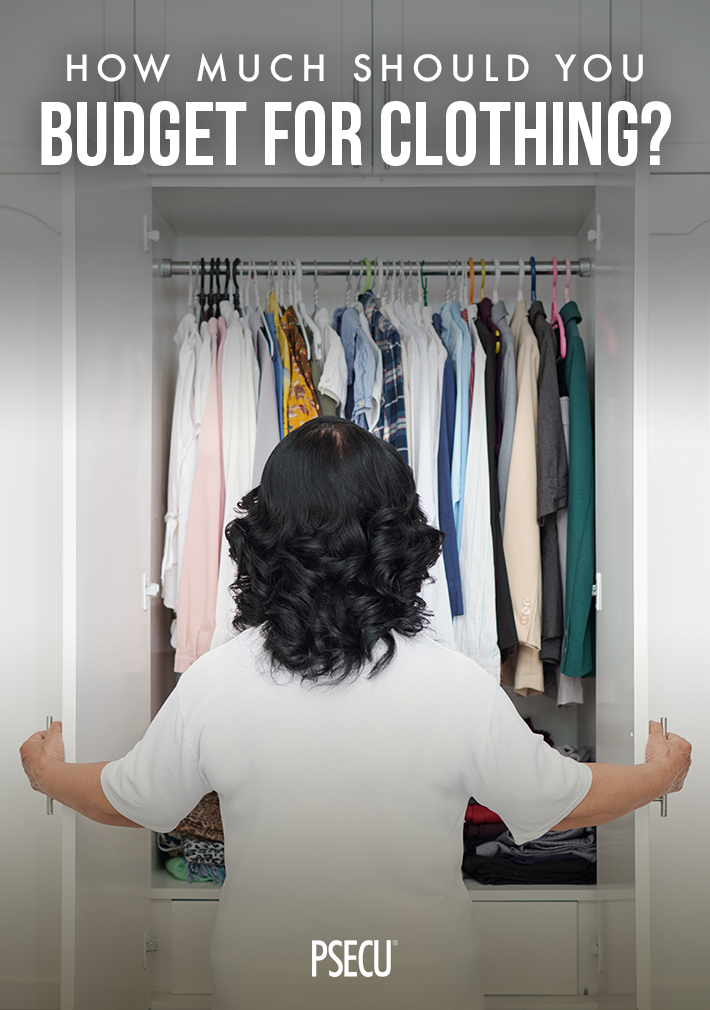Most financial experts recommend spending no more than 5% of your monthly take-home pay on clothing. Depending on your salary and spending habits, that percentage may seem like too little or too much.
No matter what portion of your monthly income you allocate to new clothing, learning to stay on budget when you’re shopping for it is essential. Here are some ideas to help you create a stylish, functional wardrobe without breaking your budget.
How Much Can I Spend on Clothing?
Budgeting for the amount you’ll spend on clothing is helpful for reining in shopping sprees and impulse purchases.
Calculate your monthly clothing budget by multiplying your monthly take-home pay by 0.05. If you bring $3,000 home each month, for example, you should aim to spend no more than $150 on clothes.
If you don’t have that kind of space in your budget to buy clothes, or you’re spending much more than that each month, consider reviewing your monthly expenses and re-evaluating your budget.
Saving vs. Splurging
Where do you shop for clothing? Finding most of your clothes at less expensive stores and turning to high-end brands for go-to pieces only is a smart way to make the most out of your monthly clothing budget.
Which pieces are worthy of an investment, and which should you try to save money on?
Clothing to Save On
High-quality staples have their place in a wardrobe, but there are some items that are okay to spend a little less on.
- T-shirts: Items like t-shirts are available in a wide variety of prices and styles. They’re also relatively easy to find, so if they fall apart, shrink, or get stained, it won’t be tough or expensive to find a replacement.
- Skirts and pants: It’s possible to find appealing pieces at low prices. If the item fits well, it’ll look just as good as an expensive item – and if something happens to it, you won’t have regrettably paid a small fortune for it.
- Trendy pieces: Jewelry, blouses, and other items that change with trends are great pieces to save on. Since you’ll likely only wear these clothes while they’re in style, it’s better not to spend a lot on them.
Clothing to Splurge On
Some clothing staples have to stand up to heavy use. Splurge on these pieces so you can wear them for several years to come.
- Blazers and jackets: Blazers and jackets are exceedingly versatile and can be worn with many items in your closet. Investing in high-quality blazers and jackets helps to ensure they’ll withstand heavy use.
- Sweaters: Buy a couple of high-quality sweaters that can keep their cozy qualities for a few years. Like jackets, sweaters can be worn with many outfits. You’ll want something that doesn’t start fading or pilling after being worn just a couple of times.
- Warm coat: If you live in an area with cold winters, a well-made coat is a vital part of your wardrobe. Spending extra money on a winter coat is a good idea, as higher-quality pieces can last through many seasons.
Splurging on something just to regret it later is a common feeling. Consider which items you pay more for carefully to avoid buyer’s remorse.
Invest in Clothing You’ll Actually Wear
What you’re willing to pay for a particular piece comes down to your personal preference. Take hats and scarves, for example. While you get what you pay for with these accessories, a less expensive winter hat can still keep you warm. You can find an abundance of inexpensive scarves, but a well-made cashmere piece may be a smart investment if you’ll use it often.
When you go shopping, you know better than anyone which clothes you’ll wear the most and how durable those pieces must be. If you dress in business casual clothing, you might choose to save on jeans and splurge on a vintage necklace you’ll wear every day.
Building a Professional Wardrobe on a Budget
Beyond dress codes and professional expectations at work, the right outfit can give you extra confidence for a presentation or make you feel more powerful as you work through daily tasks.
Professional clothing is often expensive. Fortunately, there are a few ways you can find affordable clothing to boost your wardrobe for work.
- Take Advantage of Sales and CouponsMany stores offer sales, coupons, and discounts throughout the year. These can help you get the clothing you need for your professional wardrobe and still save. Some stores also offer specific rewards programs for shopping with them. These rewards can add up.If you need several items, try splitting up your shopping trips to take advantage of rewards or coupons that are valid at a later date. For instance, buy a few blouses, a couple pairs of pants, and a skirt now, letting your rewards or coupons accumulate. Once you get your rewards, use them to purchase some other items on your list.
- Buy Clothing SecondhandWhen you want to add well-made, unique pieces to your professional wardrobe, you can buy them secondhand. Thrifting makes brand-name and vintage clothing affordable. What’s more, buying secondhand clothes is a sustainable choice. It saves unwanted clothing from going to the landfill and can cut down on the use of natural resources. Secondhand shopping can be a win-win for both the environment and your wallet.
PSECU Can Help You Manage Your Money
It’s possible to get the clothing you need, or want, and still stay on budget. For more tips on managing your money, visit our WalletWorks page.
The content provided in this publication is for informational purposes only. Nothing stated is to be construed as financial or legal advice. Some products not offered by PSECU. PSECU does not endorse any third parties, including, but not limited to, referenced individuals, companies, organizations, products, blogs, or websites. PSECU does not warrant any advice provided by third parties. PSECU does not guarantee the accuracy or completeness of the information provided by third parties. PSECU recommends that you seek the advice of a qualified financial, tax, legal, or other professional if you have questions.


